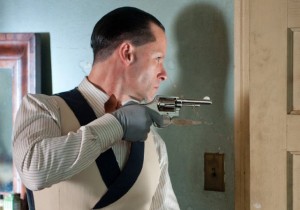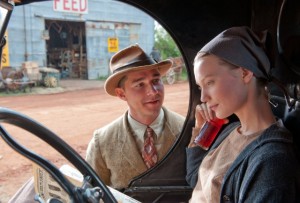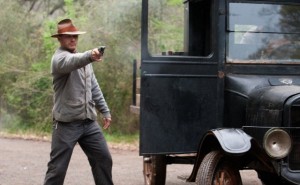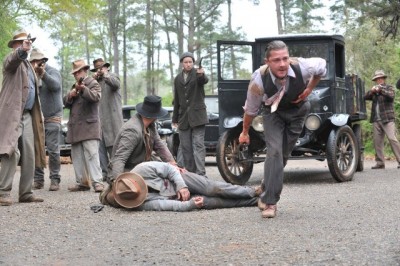
John Hillcoat’s Lawless, much like his last two films — the often ugly The Proposition (2005) and the dour, depressing The Road (2009) — is more a movie to be admired than genuinely enjoyed. While I’m not one to shy away from on-screen nastiness, there’s a repulsiveness and visceral nature to the way the director and screenwriter/musician/frequent Hillcoat collaborator Nick Cave approach violence that’s discomforting and borderline repugnant. There’s little that’s shocking or provocative in the bloodthirsty way that Lawless approaches the tale of three brothers bootlegging moonshine in the mountains of Virginia during the height of the Depression. Rather, there’s a sense of brutality and nihilism (perhaps this is the true nature of the movie’s title), and the feeling that no character is safe and that nothing good can come from anyone, which makes the film difficult — for me, at least — to sit through. Even the film’s attempt at a quirky — maybe even fun — villain in the form of Guy Pearce’s crooked, foppish government agent is ultimately downright vile and disgusting.

There’s an occasionally sardonic tone and a surprisingly modern soundtrack (right down to two separate covers of The Velvet Underground’s “White Light/White Heat”). The latter adds levity, while the former adds playfulness, but it’s never enough. It wasn’t until the film’s welcome and quaint ending that I realized there truly was a heart buried beneath the film’s bloodied facade. While this does increase the chance that I’ll find the film less grim on a second viewing, I only got to this point after sitting through nearly 2 hours of ugliness. Many will have the exact opposite reaction, finding all this bad medicine much more profound than I, and coming away disappointed by a somewhat happy ending (at least as much as a movie like Lawless can have one) that betrays much of the film’s disturbing nature.

Regardless of where your tastes lie, the film is stylishly filmed by Hillcoat, whose occasional flourishes of artsiness maybe hint at a more waggish director who lies beneath. He’s also got a great cast to work with, and even manages to get a solid performance out of the often-distracting Shia LaBeouf as our protagonist. LaBeouf, whose recent headline-making smacks of an actor who so desperately wants to be taken seriously, never lets his often smug personality and usual onscreen persona creep into the film. It’s a relief, too, because his role — as Jack Bondurant, the inept runt of his family, who shies away from the violence his brothers deal in — is the film’s center, and is left with the bulk of Lawless’ heavy emotional lifting. Putting this much of Lawless on his back could’ve (and really should’ve) been disastrous — especially against much better performers like Tom Hardy, Gary Oldman and the innately likable Mia Wasikowska. There are occasional lapses of histrionic serious acting, but thankfully we get more Jack Bondurant than Shia LaBeouf.

Throughout the movie, the things that Lawless attempts but doesn’t quite pull off — a sense of humor, an occasional poetic cinematic embellishment — made me unable to shake the feeling that I’d rather be watching the Coen Brothers’ Miller’s Crossing. As a flawless balancing act between gritty noir gangster flick and caustic dark comedy, the Coens’ film is the perfect embodiment of what Hillcoat’s film — in an untainted world — would be. That it doesn’t meet the standards of that far superior film is nothing to be ashamed of, but that failure does illuminate a lot of what’s wrong and flawed about Lawless. Rated R for strong bloody violence, language and some sexuality/nudity.





there